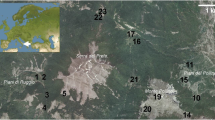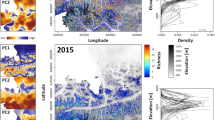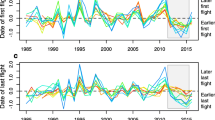Abstract
Climate and land cover changes are known to exert strong pressure on mountain biodiversity, but the potential interactions between these drivers remain unknown. Research concerning how changes in climate and land cover impact montane species is often based on single-year and short-term studies, which can limit the conclusions about population trends. We used meteorological and vegetation structure data, butterfly counts for 57 species over 14 years, and species’ ecological characteristics to examine how changes in climate and land cover affect trends in butterfly populations in a Mediterranean mountain range. Temperature, forest area, shrub cover and vegetation height increased over time, at similar rates across the elevational gradient. While 35% of the butterfly species showed stability in temporal abundance, the proportions that decreased and increased in abundance were similar (24–28%), with comparable rates across the elevational gradient. Species associated with open habitats, and with larval feeding on herbs and grasses, tended to decrease in abundance more than those associated with closed habitats, and with larval feeding on woody plants, thus indicating that population changes were mainly related to vegetation encroachment, but not climate warming. Our findings support the idea that mountains can act as climate refugia relative to more disturbed flat lowlands, which are usually inhabited by butterfly populations tending to decrease in abundance. They also suggest that possible effects of interactions between vegetation encroachment and climate change may counteract negative warming impacts on populations by microclimatic cooling, thus enabling potential adaptation to climate change and protection of biodiversity.





Similar content being viewed by others
Data Availability
Data available from figshare repository: https://doi.org/10.6084/m9.figshare.22280407.v1
References
Angert AL, Crozier LG, Rissler LJ, Gilman SE, Tewksbury JJ, Chunco AJ (2011) Do species’ traits predict recent shifts at expanding range edges? Ecol Lett 14:677–689
Ashton S, Gutiérrez D, Wilson RJ (2009) Effects of temperature and elevation on habitat use by a rare mountain butterfly: implications for species responses to climate change. Ecol Entomol 34:437–446
Barnagaud JY, Devictor V, Jiguet F, Barbet-Massin M, Le Viol I, Archaux F (2012) Relating habitat and climatic niches in birds. PLoS ONE 7:e32819
Bartoń K (2019) MuMIn: Multi-Model Inference. R package version 1.43.6
Bogaart P, Van der Loo M, Pannekoek J (2018) rtrim: Trends and Indices for Monitoring Data. R package version 2.0.6
Breed GA, Stichter S, Crone EE (2013) Climate-driven changes in northeastern US butterfly communities. Nat Clim Change 3:142–145
Butler MA, King AA (2004) Phylogenetic comparative analysis: a modelling approach for adaptive evolution. Am Nat 164:683–695
Burnham KP, Anderson DR (2002) Model selection and multimodal inference: a practical-theoretic approach. Springer-Verlag, New York
Carnicer J, Stefanescu C, Vives-Ingla M, López C, Cortizas S, Wheat C …, Peñuelas J (2019) Phenotypic biomarkers of climatic impacts on declining insect populations: a key role for decadal drought, thermal buffering and amplification effects and host plant dynamics. J Anim Ecol 88:376–391
Colom P, Ninyerola M, Pons X, Traveset A, Stefanescu C (2022) Phenological sensitivity and seasonal variability explain climate-driven trends in Mediterranean butterflies. Proc Royal Soc Biol Sci 289:20220251
Curtis RJ, Brereton TM, Dennis RLH, Carbone C, Isaac NJB (2015) Butterfly abundance is determined by food availability and is mediated by species traits. J Appl Ecol 52:1676–1684
Dapporto L, Cini A, Vodă R, Dinca V, Wiemers M, Menchetti M …, Vila R (2019) Integrating three comprehensive data sets shows that mitochondrial DNA variation is linked to species traits and paleogeographic events in european butterflies. Mol Ecol Resour 19:1623–1636
De Frenne P, Zellweger F, Rodríguez-Sánchez F, Scheffers BR, Hylander K, Luoto M …, Lenoir J (2019) Global buffering of temperatures under forest canopies. Nat Ecol Evol 3:744–749
del Río S, Herrero L, Pinto-Gomes C, Penas A (2011) Spatial analyses of mean temperature trends in Spain over the period 1961–2006. Glob Planet Change 78:65–75
Didham RK, Basset Y, Collins CM, Leather SR, Littlewood NA, Menz MHM …, Hassall C (2020) Interpreting insect declines: seven challenges and a way forward. Insect Conserv Divers 13:103–114
Doxa A, Kamarianakis Y, Mazaris AD (2022) Spatial heterogeneity and temporal stability characterize future climatic refugia in Mediterranean Europe. Glob Change Biol 28:2413–2424
Dulle HI, Ferger SW, Cordeiro NJ, Howell KM, Schleuning M, Böhning-Gaese K, Hof C (2016) Changes in abundances of forest understorey birds on Africa’s highest mountain suggest subtle effects of climate change. Divers Distrib 22:288–299
Eglington SM, Pearce-Higgins JW (2012) Disentangling the relative importance of changes in climate and land-use intensity in driving recent bird population trends. PLoS ONE 7:e30407
Environmental Systems Research Institute (ESRI) (2012) ArcGIS Desktop version 10.5. Redlands, CA
Felton A, Gustafsson L, Roberge J-M, Ranius T, Hjältén J, Rudolphi J, Lindbladh M, Weslien J, Rist L, Brunet J, Felton AM (2016) How climate change adaptation and mitigation strategies can threaten or enhance the biodiversity of production forests: insights from Sweden. Biol Conserv 194:11–20
Flousek J, Telenský T, Hanzelka J, Reif J (2015) Population trends of central european montane birds provide evidence for adverse impacts of climate change on high-altitude species. PLoS ONE 10:e0139465
Forister ML, McCall AC, Sanders NJ, Fordyce JA, Thorne JH …, Shapiro AM (2010) Compounded effects of climate change and habitat alteration shift patterns of butterfly diversity. Proc Natl Acad Sci USA 107:2088–2092
Forister M, Jahner J, Casner K, Wilson J, Shapiro A (2011) The race is not to the swift: long-term data reveal pervasive declines in California’s low-elevation butterfly fauna. Ecology 92:2222–2235
Fox J, Monette G (1992) Generalized collinearity diagnostics. J Am Stat Assoc 87:178–183
Fox J, Weisberg S (2019) An R Companion to Applied Regression. Third Edition. Thousand Oaks CA: Sage
Freeman BG, Scholer MN, Ruiz-Gutierrez V, Fitzpatrick JW (2018) Climate change causes upslope shifts and mountaintop extirpations in a tropical bird community. Proc Natl Acad Sci USA 115:11982–11987
Frishkoff LO, Gabot E, Sandler G, Marte C, Mahler DL (2019) Elevation shapes the reassembly of Anthropocene lizard communities. Nat Ecol Evol 3:638–646
García-Romero A, Muñoz J, Andrés N, Palacios D (2010) Relationship between climate change and vegetation distribution in the Mediterranean mountains: Manzanares Head valley, Sierra de Guadarrama (Central Spain). Clim Change 100:645–666
Gehrig-Fasel J, Guisan A, Zimmermann NE (2007) Tree line shifts in the Swiss Alps: Climate change or land abandonment? J Veg Sci 18:571–582
Gutiérrez D, Wilson RJ (2014) Climate conditions and resource availability drive return elevational migrations in a single-brooded insect. Oecologia 175:861–873
Gutiérrez D, Vila R, Wilson RJ (2016) Asymmetric constraints on limits to species ranges influence consumer-resource richness over an environmental gradient. Global Ecol Biogeogr 25:1477–1488
Halsch CA, Shapiro AM, Fordyce JA, Nice CC, Thorne JH, Waetjen DP, Forister ML (2021) Insects and recent climate change. Proc Natl Acad Sci USA 118:e2002543117
Harvey PH, Pagel MD (1991) The comparative method in evolutionary biology. Oxford University Press, Oxford
Harris JBC, Putra DD, Gregory SD, Brook BW, Prawiradilaga DM, Sodhi NS, Wei D, Fordham DA (2014) Rapid deforestation threatens mid-elevational endemic birds but climate change is most important at higher elevations. Divers Distrib 20:773–785
Herrando S, Brotons L, Anton M, Páramo F, Villero D, Titeux N, …, Stefanescu C (2016) Assessing impacts of land abandonment on Mediterranean biodiversity using indicators based on bird and butterfly monitoring data. Environ Conserv 43:69–78
Højsgaard S, Halekoh U, Yan J (2005) The R Package geepack for generalized estimating equations. J Stat Softw 15:1–11
Hsiung AC, Boyle WA, Cooper RJ, Chandler RB (2018) Altitudinal migration: ecological drivers, knowledge gaps, and conservation implications. Biol Rev 93:2049–2070
Hunter MD, Kozlov MV, Itämies J, Pulliainen E, Bäck J, Kyrö E-M, Niemelä P (2014) Current temporal trends in moth abundance are counter to predicted effects of climate change in an assemblage of subarctic forest moths. Glob Change Biol 20:1723–1737
Jiguet F, Gadot A-S, Julliard R, Newson SE, Couvet D (2007) Climate envelope, life history traits and the resilience of birds facing global change. Glob Change Biol 13:1672–1684
Kharouba HM, Paquette SR, Kerr JT, Vellend M (2014) Predicting the sensitivity of butterfly phenology to temperature over the past century. Glob Change Biol 20:504–514
Kuemmerle T, Levers C, Erb K, Estel K, Jepsen MR, Müller D …, Verbung PH (2016) Hotspots of land use change in Europe. Environ Res Lett 11(6):1–14
Lai J (2022) Generalizing hierarchical and variation partitioning in multiple regression and canonical analysis using the rdacca.hp R package. Methods Ecol Evol 13:782–788
Lehikoinen A, Green M, Husby M, Kålås JA, Lindström à (2013) Common montane birds are declining in northern Europe. J Avian Biol 45:3–14
Lehikoinen A, Brotons L, Calladine J, Campedelli T, Escandell V, Flousek J …, Trautmann S (2019) Declining population trends of european mountain birds. Glob Change Biol 25:577–588
Mac Nally R, Walsh CJ (2004) Hierarchical partitioning public-domain software. Biodivers Conserv 13:659–660
Mantyka-Pringle CS, Martin TG, Rhodes JR (2012) Interactions between climate and habitat loss effects on biodiversity: a systematic review and meta-analysis. Glob Change Biol 18:1239–1252
Melero Y, Stefanescu C, Pino J (2016) General declines in Mediterranean butterflies over the last two decades are modulated by species traits. Biol Conserv 201:336–342
Merrill RM, Gutiérrez D, Lewis OT, Gutiérrez J, Díez SB, Wilson RJ (2008) Combined effects of climate and biotic interactions on the elevational range of a phytophagous insect. J Anim Ecol 77:145–155
Mingarro M, Cancela JP, Burón-Ugarte A, García-Barros E, Munguira ML, Romo H, Wilson RJ (2021) Butterfly communities track climatic variation over space but not time in the Iberian Peninsula. Insect Conserv Divers 14:647–660
Nice CC, Forister ML, Harrison JG, Gompert Z, Fordyce JA, Thorne JH …, Shapiro AM (2019) Extreme heterogeneity of population response to climatic variation and the limits of prediction. Glob Change Biol 25:2127–2136
Nieto-Sánchez S, Gutiérrez D, Wilson RJ (2015) Long-term change and spatial variation in butterfly communities over an elevational gradient: driven by climate, buffered by habitat. Divers Distrib 21:950–961
Nogués-Bravo D, Araújo MB, Erread MP, Martínez-Rica JP (2007) Exposure of global mountain systems to climate warming during the 21st Century. Glob Environ Change 17:420–428
Oliver TH, Morecroft MD (2014) Interactions between climate change and land use change on biodiversity: attribution problems, risks, and opportunities. WIREs Clim Change 5:317–335
Pannekoek J, Van Strien AJ (2005) TRIM 3 manual. Trends and indices for monitoring data. CBS, Statistics Netherlands, Voorburg, Netherlands
Paradis E, Schliep K (2018) Ape 5.0: an environment for modern phylogenetics and evolutionary analyses in R. Bioinformatics 35:526–528
Pardo F, Gil L (2005) The impact of traditional land use on woodlands: a case study in the Spanish Central System. J Hist Geogr 31:390–408
Pepin N, Bradley RS, Diaz HF, Baraer M, Caceres EB, Forsythe N …, Yang D (2015) Elevation-dependent warming in mountain regions of the world. Nat Clim Change 5:424–430
Pereira HM, Leadley PW, Proença V, Alkemade R, Scharlemann JPW, Fernández-Manjarrés J …, Wallpole M (2010) Scenarios for global biodiversity in the 21st century. Science 330:1496–1501
Pinheiro J, Bates D, DebRoy S, Sarkar D, R Core Team (2019). nlme: Linear and Nonlinear Mixed Effects Models. R package version 3.1–139
Pollard E, Yates T (1993) Monitoring butterflies for ecology and conservation. Chapman and Hall, London
Price MF, Gratzer G, Duguma L, Kohler T, Maselli D, Romeo R (2011) Mountain Forests in a Changing World - Realizing Values, addressing challenges. Published by FAO/MPS and SDC, Rome
R Core Team (2019) R: a language and environment for statistical computing. R Foundation for Statistical Computing, Vienna, Austria
Rodríguez-Rodríguez D, Bomhard B, Butchart SHM, Foster MN (2011) Progress towards international targets for protected area coverage in mountains: a multi-scale assessment. Biol Conserv 144:2978–2983
Rumpf SB, Hülber K, Zimmermann NE, Dullinger S (2019) Elevational rear edges shifted at least as much as leading edges over the last century. Glob Ecol Biogeogr 28:533–543
Saarinen K, Lahti T, Marttila O (2003) Population trends of finnish butterflies (Lepidoptera: Hesperioidea, Papilionoidea) in 1991–2000. Biodivers Conserv 12:2147–2159
Schweiger O, Harpke A, Wiemers M, Settele J (2014) CLIMBER: climatic niche characteristics of the butterflies in Europe. ZooKeys 367:65–84
Sirami C, Caplat P, Popy S, Clamens A, Arlettaz R, Jiguet F, Brotons L, Martin J-L (2017) Impacts of global change on species distributions: obstacles and solutions to integrate climate and land use. Global Ecol Biogeogr 26:385–394
Slancarova J, Bartonova A, Zapletal M, Kotilinek M, Faltynek Fric Z …, Konvicka M (2016) Life history traits reflect changes in Mediterranean butterfly communities due to forest encroachment. PLoS ONE 11:e0152026
Socolar JB, Epanchin PN, Beissinger SR, Tingley MW (2017) Phenological shifts conserve thermal niches in north american birds and reshape expectations for climate-driven range shifts. Proc Natl Acad Sci USA 114:12976–12981
Stefanescu C, Torre I, Jubany J, Páramo F (2011) Recent trends in butterfly populations from north-east Spain and Andorra in the light of habitat and climate change. J Insect Conserv, 15:83-93
Stewart JE, IIlán JG, Richards SA, Gutiérrez D, Wilson RJ (2020) Linking inter-annual variation in environment, phenology, and abundance for a montane butterfly community. Ecology 101:e02906
Tellería JL (2019) Altitudinal shifts in forest birds in a Mediterranean mountain range: causes and conservation prospects. Bird Conserv Int 29:1–11
Ubach A, Páramo F, Gutiérrez C, Stefanescu C (2020) Vegetation encroachment drives changes in the composition of butterfly assemblages and species loss in Mediterranean ecosystems. Insect Conserv Divers 13:151–161
Ubach A, Páramo F, Stefanescu C (2021) Heterogeneidad en las respuestas demográficas asociadas al gradiente altitudinal: el caso de las mariposas en el noreste ibérico. Ecosistemas 30(1):2148
Van Swaay C, Warren M, Lois G (2006) Biotope use and trends of european butterflies. J Insect Conserv 10:189–209
Violle C, Navas ML, Vile D, Kazakou E, Fortunel C, Hummel I, Garnier E (2007) Let the concept of trait be functional! Oikos 116:882–892
Wagner DL (2020) Insect declines in the Anthropocene. Ann Rev Entomol 65:1–24
Wepprich T, Adrion JR, Ries L, Wiedmann J, Haddad NM (2019) Butterfly abundance declines over 20 years of systematic monitoring in Ohio, USA. PLoS ONE 14:e0216270
Wickham H (2016) ) ggplot2: elegant graphics for data analysis. Springer-Verlag, New York
Wilson R, Gutiérrez D, Gutiérrez J, Martinez DR, Agudo R, Monserrat V (2005) Changes to the elevational limits and extent of species ranges associated with climate change. Ecol Lett 8:1138–1146
Acknowledgements
R.J. Wilson, S.B. Díez, J. Gutiérrez Illán, A. Miralles, S. Nieto-Sánchez, D. Martínez, I. Martínez, R. Agudo, M. Jiménez, P. Arribas, E. Gómez, M. Echeverri, D. Mayor and M. Losa assisted with field work, and R.M. Viejo and two anonymous reviewers provided comments on the manuscript. The research was funded by the Spanish Ministry of Economy and Competitiveness (CGL2005-06820/BOS, CGL2008-04950/BOS, CGL2011-30259 and CGL2014-57784-P to D.G.) and Comunidad de Madrid (PEJD-2017-PRE/AMB-4075 to D.G.). Access and research permits were provided by Comunidad de Madrid, Parque Nacional de la Sierra de Guadarrama, Parque Regional de la Cuenca Alta del Manzanares, Parque Regional del Curso Medio del Río Guadarrama, Patrimonio Nacional and Ayuntamiento de Cercedilla. Climatic data from meteorological stations were provided by AEMET (Agencia Estatal de Meteorología), and orthoimages by IGN (Instituto Geográfico Nacional). C. Francis revised the English.
Funding
The research was funded by the Spanish Ministry of Economy and Competitiveness (CGL2005-06820/BOS, CGL2008-04950/BOS, CGL2011-30259 and CGL2014-57784-P to D.G.) and Comunidad de Madrid (PEJD-2017-PRE/AMB-4075 to D.G.).
Author information
Authors and Affiliations
Contributions
D.G. conceived the ideas and designed the methodology. E.C.-M. and D.G. collected field data. E.C.-M. extracted data from literature, constructed the database and analysed the data. E.C.-M. and D.G. created the figures and wrote the paper. All authors consent for publication of this study.
Corresponding author
Ethics declarations
Conflict of interest and competing interests
Authors have no conflict of interest to declare neither relevant financial or non-financial interests to disclose.
Ethical approval
Not applicable.
Additional information
Communicated By Louise Ashton
Publisher’s Note
Springer Nature remains neutral with regard to jurisdictional claims in published maps and institutional affiliations.
Electronic supplementary material
Below is the link to the electronic supplementary material.
Rights and permissions
Springer Nature or its licensor (e.g. a society or other partner) holds exclusive rights to this article under a publishing agreement with the author(s) or other rightsholder(s); author self-archiving of the accepted manuscript version of this article is solely governed by the terms of such publishing agreement and applicable law.
About this article
Cite this article
Caro-Miralles, E., Gutiérrez, D. Butterfly population trends track vegetation encroachment but not climate warming in a Mediterranean mountain. Biodivers Conserv 32, 2017–2035 (2023). https://doi.org/10.1007/s10531-023-02589-9
Received:
Revised:
Accepted:
Published:
Issue Date:
DOI: https://doi.org/10.1007/s10531-023-02589-9




